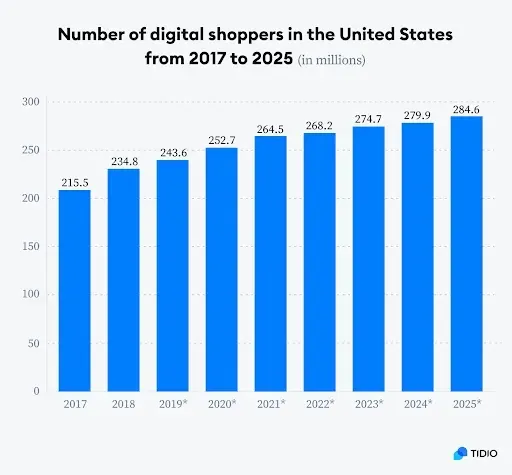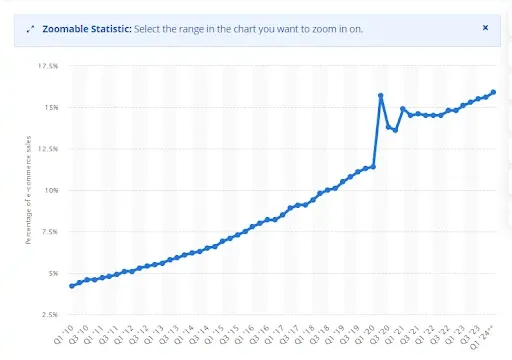In this article, you’ll learn:
9.2 million to 26.5 million. This is the number of online stores that have grown from 2019 to 2023.
This surge is mirrored by a jump in online shoppers in the US. As you can see in the chart below, it has risen from 215.5 million in 2017 and is expected to hit 284.6 million by 2025.

But what has led to this immense growth?
The answer is: easy access to the internet, user-friendly tools, and growing trust in online shopping.
This makes e-commerce not only an easy business to start but also the right business to jump on. In fact, In the US alone, it accounted for 15.9 percent of total sales in 2024.

This demonstrates its large profit potential.
But before you start preparing, it's important to know all the key steps involved in starting an e-commerce business. So, what are these steps? Let’s find out!
Why Start an E-commerce Business?
E-commerce stores offer a lot of advantages. Some of which are:
- They cost less to run than physical stores because you don't need to pay any rent.
- You just need a domain name, e-commerce hosting, inventory, and digital marketing to begin.
- You can also reach customers anywhere, not just those near your store. This means more potential sales and success.
- It's easier to grow your business online, too. You can simply expand your website and store without needing to open new physical locations.
- E-commerce also offers flexibility for customers. They can shop anytime and anywhere they have an internet connection. This convenience keeps customers happy and coming back.
How to Start an E-commerce Business: A Step-by-Step Guide
Identifying Your Passion and Skills
To succeed online, figure out your niche first. What are you good at? What skills can you turn into a business? What do you want to sell?
Once you have an idea, look at similar businesses.
See what's working for them and where they could improve.
Study successful businesses and ask yourself:
- How do they reach customers?
- What do you like about their website?
- How do they make money?
Gather as many ideas as you can because there's a lot of competition in e-commerce. Think carefully about what makes your business unique before you start building it.
Conduct Market Research
Don't rush into building your store after you've chosen your niche and products. Take some time to understand your target customers and competitors. This helps you tailor your products to meet any unmet needs.
You can research the market in many ways. Talk to your target customers and ask them what they want. Look at your competitors' marketing and what they share online. Read market reports to spot trends and gaps. Agencies offering SEO, PPC, email campaigns, or social media management often use white label marketing services to deliver tasks without building their own tools.
If you can't afford your own research, look for existing market research, trends data, and reports. To help you gain actionable insights without extensive manual effort, a purpose-built scraping solution can efficiently gather competitor and market data.
Validating Your Idea
Before pursuing your business idea, make sure to validate it by checking two key things:
First, the market. How big is it? Who are your competitors? Who is your target audience? Are your products or services in demand, or are they in a market that's not growing?
Second, your products or services. What’s the price point? How big, heavy, or durable are they? Are they seasonal? Are there any rules or regulations to consider? Do they solve a problem, or are they more of a want?
Evaluating these factors will help you determine if your business idea has real potential.
Developing a Business Plan
Your e-commerce business plan is your guide to online success. It's where you'll detail your winning products, build a loyal customer base, and create a clear path to profit.It’s also where you’ll decide and determine the business structure to register — something you can get help with from business formation services or its competitors.
A solid business plan isn't just paperwork. It's your secret weapon for:
- Finding your ideal customers
- Setting profitable prices
- Making smart investments
- Avoiding common pitfalls
- Impressing potential investors
If you need a little help, many AI business plan generator tools can do the heavy lifting. Just tell them about your products, target market, and financial goals, and they'll quickly create a professional business plan in no time.
Choosing a Business Model
E-commerce isn't just about selling things online, there are different business models to do it:
Some of which are:
- Direct-to-consumer (DTC): You make and ship your products straight to the customer. No middleman involved.
- Dropshipping: You sell products without keeping any stock. The supplier ships directly to the customer when they order. It's great for starting on a budget.
- Print on demand: This is like dropshipping but for custom-printed stuff like T-shirts or mugs. They're only made when someone orders them.
- Wholesaling: You sell a lot of stuff at once to other stores for a discount. It's profitable, but you need money upfront to buy all the stock.
- Subscriptions: You sell things or services regularly, like monthly boxes or online courses.
- Private label: You have someone else make your product, but you decide what it's like and how it looks. This costs more to set up.
Once you've chosen your model, sort out shipping. If you're using a website builder, see if it helps with labels or calculating costs. Check how much it costs to ship your products and if there are any places you can't ship to.
Choosing the Right E-commerce Platform
There are many options available to host your online store, including website builders and e-commerce platforms, designed for both small and large-scale enterprise ecommerce businesses. So, which one should you choose?
Website builders like Wix or WordPress allow you to create a full website, with an online store being just one part of it. You can include pages about yourself, showcase your work, let people book appointments, and even offer online courses.
On the other hand, e-commerce platforms like Shopify or WooCommerce are better suited for dedicated online selling. While they also offer pages for your business, images, and blogs, they come with specialized tools for online stores, such as shopping carts, WooCommerce abandoned cart plugins, and many such more.
Designing Your Online Store
Now it's time to design your online store, the heart of your business. Website builders have many free and paid themes you can easily customize and install.
Try out different themes to see what fits your style. Pick one that lets you make a lot of changes.
For example, if you sell custom T-shirts, choose a theme that lets you add features where customers can put text or images on their shirts. You can even add a feature to let them see a preview before they buy.
Marketing Your E-commerce Business
Once you're ready, it's time to spread the word and start selling! Thanks to your prior research, you know where your audience hangs out online. Now, use that knowledge to your advantage.
If you have a blog, promote it across all your social media channels. Share content that interests your audience on platforms like Twitter, Instagram, or YouTube.
Try different marketing tactics, such as Instagram ads or affiliate partnerships. Also, create landing pages that make it easy for people to purchase your products.
Growing and Scaling Your E-commerce Business
As a small business owner, it can be tough to stay on top of everything, but with effective small business website design, you can make the most of what you already have. A well-crafted online presence helps showcase your offerings and reach more customers without overwhelming your resources.
For example:
- Capture pictures and videos of your daily work or behind-the-scenes moments. These can be used on social media or your website.
- If you're researching a topic related to your business, turn it into a marketing email or blog post to boost your SEO.
- When designing marketing materials like email layouts or Instagram Stories, create reusable templates to save time in the future.
By repurposing your content, you'll maximize its value and free up more time to focus on growing your business.
Tips for Starting an E-commerce Business
To make your ecommerce store successful:
- Keep customers happy and coming back with great service, rewards, discounts, and new products.
- Offer free or discounted shipping if possible.
- Provide good customer service with friendly people, live chat, and 24/7 availability.As you think of expanding your e-commerce business, one significant step is exploring multi channel ecommerce integration solutions. These systems enable you to manage products across various platforms seamlessly, reducing operational headaches and maximizing sales opportunities.
- Sell your products in more places, like Amazon and social media.
- Suggest upgrades or related products to increase sales.
Conclusion
Launching your e-commerce business is just the first step. Keep experimenting with different digital marketing strategies until you find the one that works best for you. Also, stay up to date with the latest e-commerce trends, e-commerce software development services, and keep an eye on what your competitors are doing. This is how you’ll scale and grow your business over time.
Did you enjoy this article? Give Pics.io a try — or book a demo with us, and we'll be happy to answer any of your questions.
Vinay Kevadiyais the founder and CEO of Upmetrics, the №1 business planning software. His ultimate goal with Upmetrics is to revolutionize how entrepreneurs create, manage, and execute their business plans. He enjoys sharing his insights on business planning and other relevant topics through his articles and blog posts.




